Malnutrition in Nepal: Causes, Effects, and Solutions for Children
VerifiedAdded on 2022/11/15
|13
|3994
|246
Essay
AI Summary
This essay provides a comprehensive analysis of the malnutrition crisis in Nepal, specifically focusing on children under the age of 5. It defines malnutrition and its categories, highlighting its significant impact on child health, including stunting, underweight, and anemia. The essay draws on various reports and studies, such as the Nepal Demographic and Health Survey, to present statistical data on the prevalence of malnutrition and its consequences, including increased mortality rates and impaired cognitive development. It explores the social determinants of health, such as poverty, food insecurity, and teenage pregnancy, as contributing factors to the problem. The essay also discusses the role of socioeconomic conditions, natural calamities, and infrastructure issues that affect food access and affordability. The study of Anna, Abhishek and Sujata (2017), also provides valuable insights into the prevalence of anemia among children and associated diseases. The essay concludes by emphasizing the need for policy interventions and stakeholder involvement to address the issue and improve child health outcomes in Nepal.

Running head: MALNUTRITION IN NEPAL
Malnutrition in Nepal
Name of the Student
Name of the University
Author Note
Malnutrition in Nepal
Name of the Student
Name of the University
Author Note
Paraphrase This Document
Need a fresh take? Get an instant paraphrase of this document with our AI Paraphraser
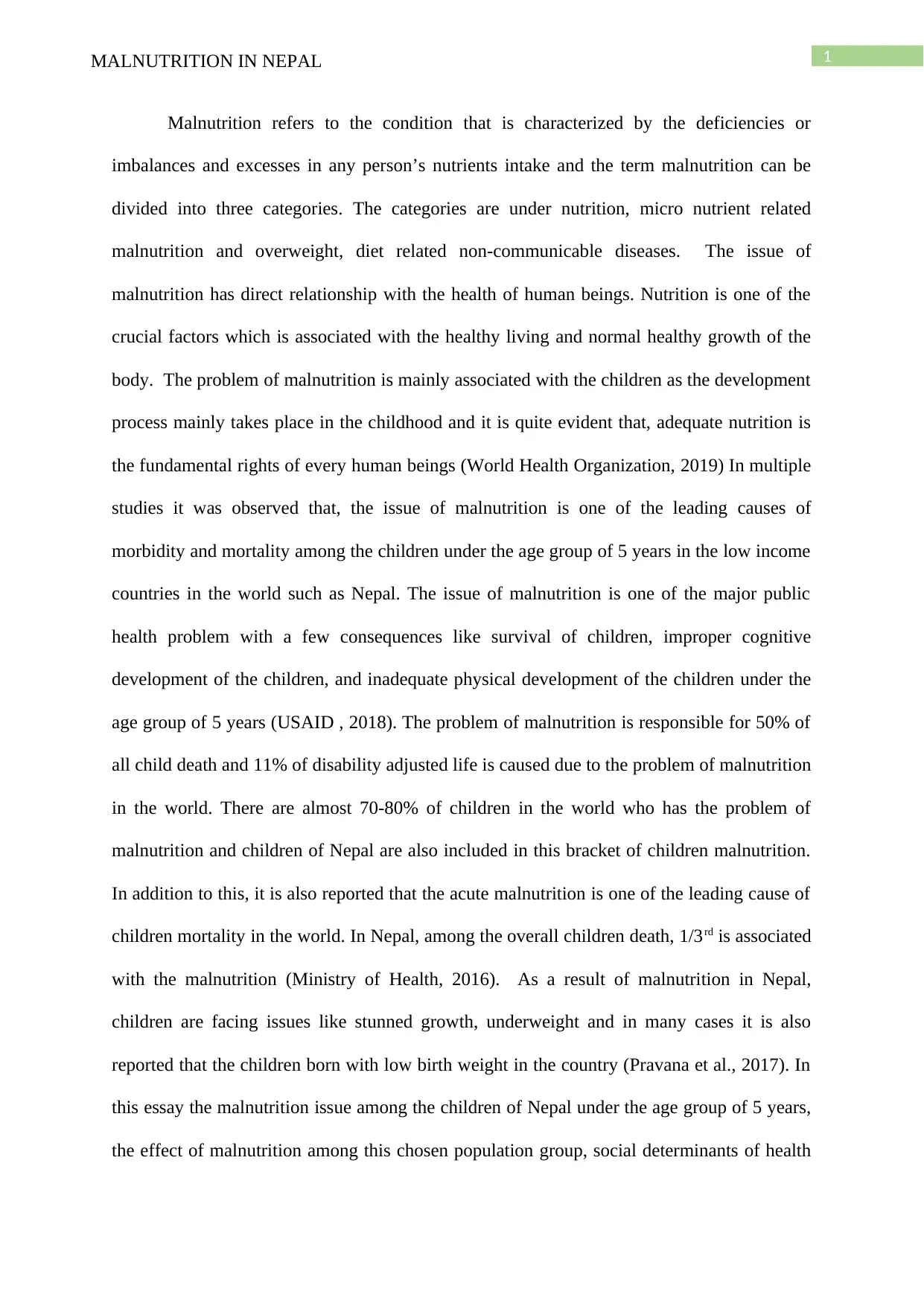
1MALNUTRITION IN NEPAL
Malnutrition refers to the condition that is characterized by the deficiencies or
imbalances and excesses in any person’s nutrients intake and the term malnutrition can be
divided into three categories. The categories are under nutrition, micro nutrient related
malnutrition and overweight, diet related non-communicable diseases. The issue of
malnutrition has direct relationship with the health of human beings. Nutrition is one of the
crucial factors which is associated with the healthy living and normal healthy growth of the
body. The problem of malnutrition is mainly associated with the children as the development
process mainly takes place in the childhood and it is quite evident that, adequate nutrition is
the fundamental rights of every human beings (World Health Organization, 2019) In multiple
studies it was observed that, the issue of malnutrition is one of the leading causes of
morbidity and mortality among the children under the age group of 5 years in the low income
countries in the world such as Nepal. The issue of malnutrition is one of the major public
health problem with a few consequences like survival of children, improper cognitive
development of the children, and inadequate physical development of the children under the
age group of 5 years (USAID , 2018). The problem of malnutrition is responsible for 50% of
all child death and 11% of disability adjusted life is caused due to the problem of malnutrition
in the world. There are almost 70-80% of children in the world who has the problem of
malnutrition and children of Nepal are also included in this bracket of children malnutrition.
In addition to this, it is also reported that the acute malnutrition is one of the leading cause of
children mortality in the world. In Nepal, among the overall children death, 1/3rd is associated
with the malnutrition (Ministry of Health, 2016). As a result of malnutrition in Nepal,
children are facing issues like stunned growth, underweight and in many cases it is also
reported that the children born with low birth weight in the country (Pravana et al., 2017). In
this essay the malnutrition issue among the children of Nepal under the age group of 5 years,
the effect of malnutrition among this chosen population group, social determinants of health
Malnutrition refers to the condition that is characterized by the deficiencies or
imbalances and excesses in any person’s nutrients intake and the term malnutrition can be
divided into three categories. The categories are under nutrition, micro nutrient related
malnutrition and overweight, diet related non-communicable diseases. The issue of
malnutrition has direct relationship with the health of human beings. Nutrition is one of the
crucial factors which is associated with the healthy living and normal healthy growth of the
body. The problem of malnutrition is mainly associated with the children as the development
process mainly takes place in the childhood and it is quite evident that, adequate nutrition is
the fundamental rights of every human beings (World Health Organization, 2019) In multiple
studies it was observed that, the issue of malnutrition is one of the leading causes of
morbidity and mortality among the children under the age group of 5 years in the low income
countries in the world such as Nepal. The issue of malnutrition is one of the major public
health problem with a few consequences like survival of children, improper cognitive
development of the children, and inadequate physical development of the children under the
age group of 5 years (USAID , 2018). The problem of malnutrition is responsible for 50% of
all child death and 11% of disability adjusted life is caused due to the problem of malnutrition
in the world. There are almost 70-80% of children in the world who has the problem of
malnutrition and children of Nepal are also included in this bracket of children malnutrition.
In addition to this, it is also reported that the acute malnutrition is one of the leading cause of
children mortality in the world. In Nepal, among the overall children death, 1/3rd is associated
with the malnutrition (Ministry of Health, 2016). As a result of malnutrition in Nepal,
children are facing issues like stunned growth, underweight and in many cases it is also
reported that the children born with low birth weight in the country (Pravana et al., 2017). In
this essay the malnutrition issue among the children of Nepal under the age group of 5 years,
the effect of malnutrition among this chosen population group, social determinants of health
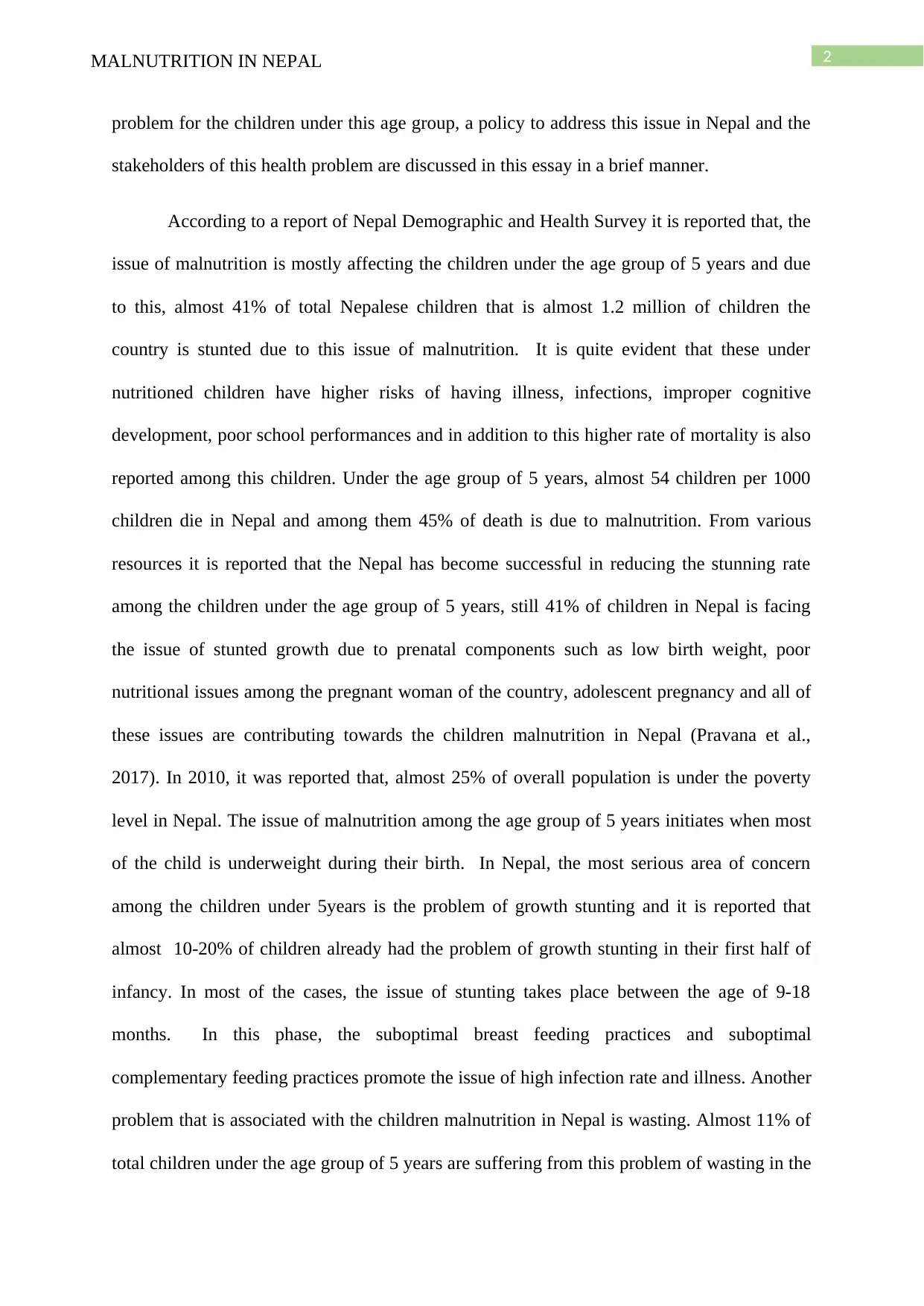
2MALNUTRITION IN NEPAL
problem for the children under this age group, a policy to address this issue in Nepal and the
stakeholders of this health problem are discussed in this essay in a brief manner.
According to a report of Nepal Demographic and Health Survey it is reported that, the
issue of malnutrition is mostly affecting the children under the age group of 5 years and due
to this, almost 41% of total Nepalese children that is almost 1.2 million of children the
country is stunted due to this issue of malnutrition. It is quite evident that these under
nutritioned children have higher risks of having illness, infections, improper cognitive
development, poor school performances and in addition to this higher rate of mortality is also
reported among this children. Under the age group of 5 years, almost 54 children per 1000
children die in Nepal and among them 45% of death is due to malnutrition. From various
resources it is reported that the Nepal has become successful in reducing the stunning rate
among the children under the age group of 5 years, still 41% of children in Nepal is facing
the issue of stunted growth due to prenatal components such as low birth weight, poor
nutritional issues among the pregnant woman of the country, adolescent pregnancy and all of
these issues are contributing towards the children malnutrition in Nepal (Pravana et al.,
2017). In 2010, it was reported that, almost 25% of overall population is under the poverty
level in Nepal. The issue of malnutrition among the age group of 5 years initiates when most
of the child is underweight during their birth. In Nepal, the most serious area of concern
among the children under 5years is the problem of growth stunting and it is reported that
almost 10-20% of children already had the problem of growth stunting in their first half of
infancy. In most of the cases, the issue of stunting takes place between the age of 9-18
months. In this phase, the suboptimal breast feeding practices and suboptimal
complementary feeding practices promote the issue of high infection rate and illness. Another
problem that is associated with the children malnutrition in Nepal is wasting. Almost 11% of
total children under the age group of 5 years are suffering from this problem of wasting in the
problem for the children under this age group, a policy to address this issue in Nepal and the
stakeholders of this health problem are discussed in this essay in a brief manner.
According to a report of Nepal Demographic and Health Survey it is reported that, the
issue of malnutrition is mostly affecting the children under the age group of 5 years and due
to this, almost 41% of total Nepalese children that is almost 1.2 million of children the
country is stunted due to this issue of malnutrition. It is quite evident that these under
nutritioned children have higher risks of having illness, infections, improper cognitive
development, poor school performances and in addition to this higher rate of mortality is also
reported among this children. Under the age group of 5 years, almost 54 children per 1000
children die in Nepal and among them 45% of death is due to malnutrition. From various
resources it is reported that the Nepal has become successful in reducing the stunning rate
among the children under the age group of 5 years, still 41% of children in Nepal is facing
the issue of stunted growth due to prenatal components such as low birth weight, poor
nutritional issues among the pregnant woman of the country, adolescent pregnancy and all of
these issues are contributing towards the children malnutrition in Nepal (Pravana et al.,
2017). In 2010, it was reported that, almost 25% of overall population is under the poverty
level in Nepal. The issue of malnutrition among the age group of 5 years initiates when most
of the child is underweight during their birth. In Nepal, the most serious area of concern
among the children under 5years is the problem of growth stunting and it is reported that
almost 10-20% of children already had the problem of growth stunting in their first half of
infancy. In most of the cases, the issue of stunting takes place between the age of 9-18
months. In this phase, the suboptimal breast feeding practices and suboptimal
complementary feeding practices promote the issue of high infection rate and illness. Another
problem that is associated with the children malnutrition in Nepal is wasting. Almost 11% of
total children under the age group of 5 years are suffering from this problem of wasting in the
⊘ This is a preview!⊘
Do you want full access?
Subscribe today to unlock all pages.

Trusted by 1+ million students worldwide
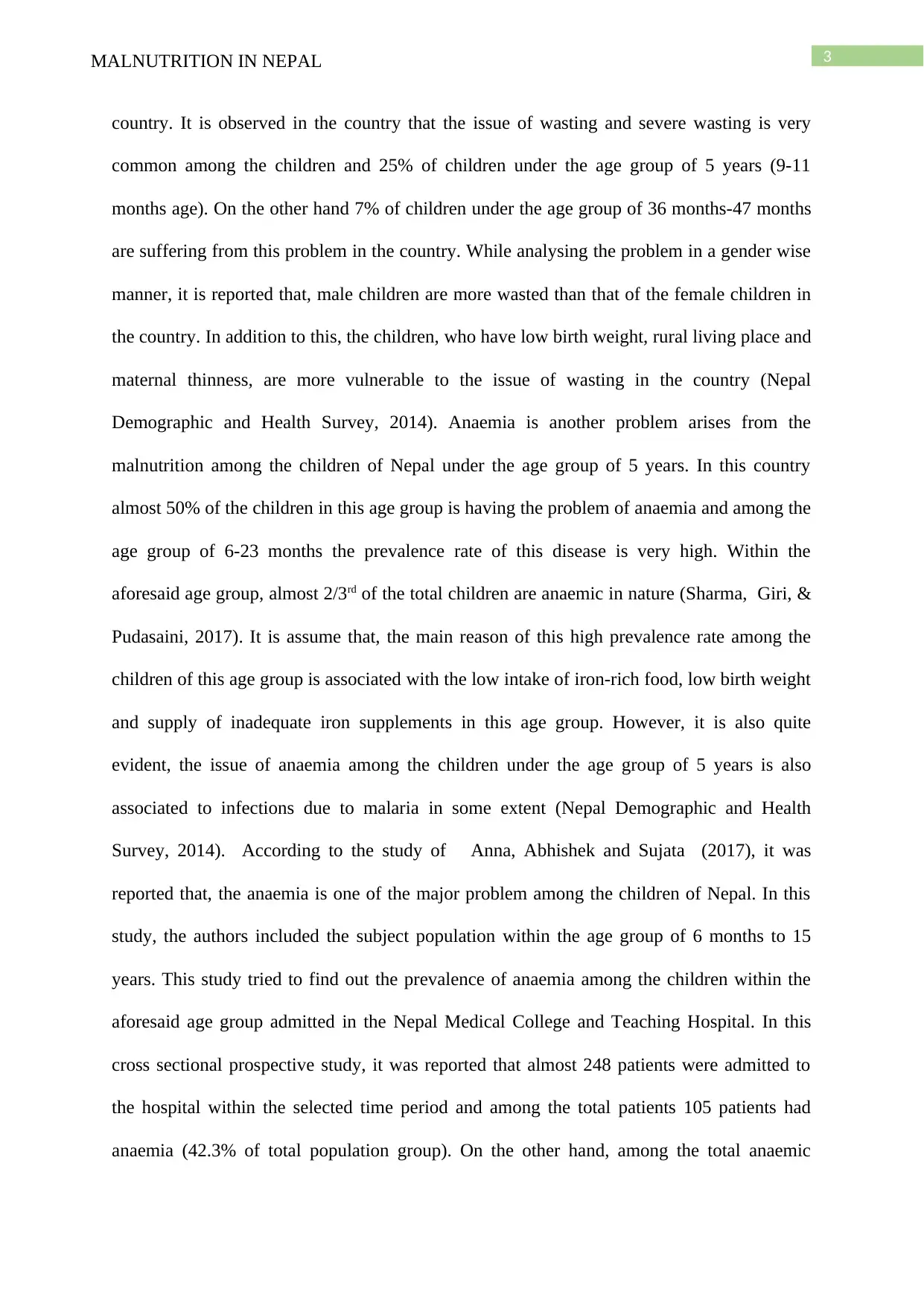
3MALNUTRITION IN NEPAL
country. It is observed in the country that the issue of wasting and severe wasting is very
common among the children and 25% of children under the age group of 5 years (9-11
months age). On the other hand 7% of children under the age group of 36 months-47 months
are suffering from this problem in the country. While analysing the problem in a gender wise
manner, it is reported that, male children are more wasted than that of the female children in
the country. In addition to this, the children, who have low birth weight, rural living place and
maternal thinness, are more vulnerable to the issue of wasting in the country (Nepal
Demographic and Health Survey, 2014). Anaemia is another problem arises from the
malnutrition among the children of Nepal under the age group of 5 years. In this country
almost 50% of the children in this age group is having the problem of anaemia and among the
age group of 6-23 months the prevalence rate of this disease is very high. Within the
aforesaid age group, almost 2/3rd of the total children are anaemic in nature (Sharma, Giri, &
Pudasaini, 2017). It is assume that, the main reason of this high prevalence rate among the
children of this age group is associated with the low intake of iron-rich food, low birth weight
and supply of inadequate iron supplements in this age group. However, it is also quite
evident, the issue of anaemia among the children under the age group of 5 years is also
associated to infections due to malaria in some extent (Nepal Demographic and Health
Survey, 2014). According to the study of Anna, Abhishek and Sujata (2017), it was
reported that, the anaemia is one of the major problem among the children of Nepal. In this
study, the authors included the subject population within the age group of 6 months to 15
years. This study tried to find out the prevalence of anaemia among the children within the
aforesaid age group admitted in the Nepal Medical College and Teaching Hospital. In this
cross sectional prospective study, it was reported that almost 248 patients were admitted to
the hospital within the selected time period and among the total patients 105 patients had
anaemia (42.3% of total population group). On the other hand, among the total anaemic
country. It is observed in the country that the issue of wasting and severe wasting is very
common among the children and 25% of children under the age group of 5 years (9-11
months age). On the other hand 7% of children under the age group of 36 months-47 months
are suffering from this problem in the country. While analysing the problem in a gender wise
manner, it is reported that, male children are more wasted than that of the female children in
the country. In addition to this, the children, who have low birth weight, rural living place and
maternal thinness, are more vulnerable to the issue of wasting in the country (Nepal
Demographic and Health Survey, 2014). Anaemia is another problem arises from the
malnutrition among the children of Nepal under the age group of 5 years. In this country
almost 50% of the children in this age group is having the problem of anaemia and among the
age group of 6-23 months the prevalence rate of this disease is very high. Within the
aforesaid age group, almost 2/3rd of the total children are anaemic in nature (Sharma, Giri, &
Pudasaini, 2017). It is assume that, the main reason of this high prevalence rate among the
children of this age group is associated with the low intake of iron-rich food, low birth weight
and supply of inadequate iron supplements in this age group. However, it is also quite
evident, the issue of anaemia among the children under the age group of 5 years is also
associated to infections due to malaria in some extent (Nepal Demographic and Health
Survey, 2014). According to the study of Anna, Abhishek and Sujata (2017), it was
reported that, the anaemia is one of the major problem among the children of Nepal. In this
study, the authors included the subject population within the age group of 6 months to 15
years. This study tried to find out the prevalence of anaemia among the children within the
aforesaid age group admitted in the Nepal Medical College and Teaching Hospital. In this
cross sectional prospective study, it was reported that almost 248 patients were admitted to
the hospital within the selected time period and among the total patients 105 patients had
anaemia (42.3% of total population group). On the other hand, among the total anaemic
Paraphrase This Document
Need a fresh take? Get an instant paraphrase of this document with our AI Paraphraser
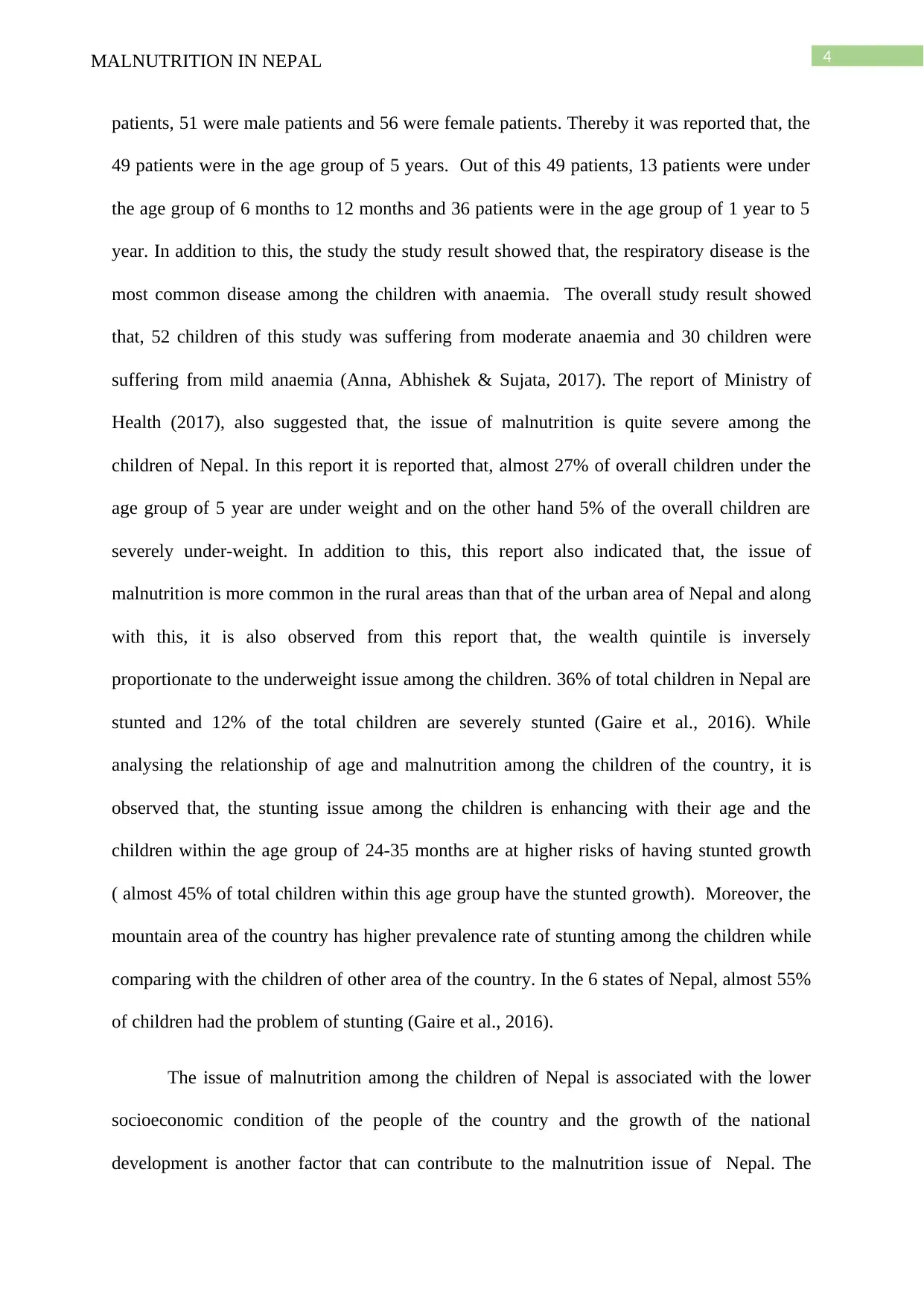
4MALNUTRITION IN NEPAL
patients, 51 were male patients and 56 were female patients. Thereby it was reported that, the
49 patients were in the age group of 5 years. Out of this 49 patients, 13 patients were under
the age group of 6 months to 12 months and 36 patients were in the age group of 1 year to 5
year. In addition to this, the study the study result showed that, the respiratory disease is the
most common disease among the children with anaemia. The overall study result showed
that, 52 children of this study was suffering from moderate anaemia and 30 children were
suffering from mild anaemia (Anna, Abhishek & Sujata, 2017). The report of Ministry of
Health (2017), also suggested that, the issue of malnutrition is quite severe among the
children of Nepal. In this report it is reported that, almost 27% of overall children under the
age group of 5 year are under weight and on the other hand 5% of the overall children are
severely under-weight. In addition to this, this report also indicated that, the issue of
malnutrition is more common in the rural areas than that of the urban area of Nepal and along
with this, it is also observed from this report that, the wealth quintile is inversely
proportionate to the underweight issue among the children. 36% of total children in Nepal are
stunted and 12% of the total children are severely stunted (Gaire et al., 2016). While
analysing the relationship of age and malnutrition among the children of the country, it is
observed that, the stunting issue among the children is enhancing with their age and the
children within the age group of 24-35 months are at higher risks of having stunted growth
( almost 45% of total children within this age group have the stunted growth). Moreover, the
mountain area of the country has higher prevalence rate of stunting among the children while
comparing with the children of other area of the country. In the 6 states of Nepal, almost 55%
of children had the problem of stunting (Gaire et al., 2016).
The issue of malnutrition among the children of Nepal is associated with the lower
socioeconomic condition of the people of the country and the growth of the national
development is another factor that can contribute to the malnutrition issue of Nepal. The
patients, 51 were male patients and 56 were female patients. Thereby it was reported that, the
49 patients were in the age group of 5 years. Out of this 49 patients, 13 patients were under
the age group of 6 months to 12 months and 36 patients were in the age group of 1 year to 5
year. In addition to this, the study the study result showed that, the respiratory disease is the
most common disease among the children with anaemia. The overall study result showed
that, 52 children of this study was suffering from moderate anaemia and 30 children were
suffering from mild anaemia (Anna, Abhishek & Sujata, 2017). The report of Ministry of
Health (2017), also suggested that, the issue of malnutrition is quite severe among the
children of Nepal. In this report it is reported that, almost 27% of overall children under the
age group of 5 year are under weight and on the other hand 5% of the overall children are
severely under-weight. In addition to this, this report also indicated that, the issue of
malnutrition is more common in the rural areas than that of the urban area of Nepal and along
with this, it is also observed from this report that, the wealth quintile is inversely
proportionate to the underweight issue among the children. 36% of total children in Nepal are
stunted and 12% of the total children are severely stunted (Gaire et al., 2016). While
analysing the relationship of age and malnutrition among the children of the country, it is
observed that, the stunting issue among the children is enhancing with their age and the
children within the age group of 24-35 months are at higher risks of having stunted growth
( almost 45% of total children within this age group have the stunted growth). Moreover, the
mountain area of the country has higher prevalence rate of stunting among the children while
comparing with the children of other area of the country. In the 6 states of Nepal, almost 55%
of children had the problem of stunting (Gaire et al., 2016).
The issue of malnutrition among the children of Nepal is associated with the lower
socioeconomic condition of the people of the country and the growth of the national
development is another factor that can contribute to the malnutrition issue of Nepal. The
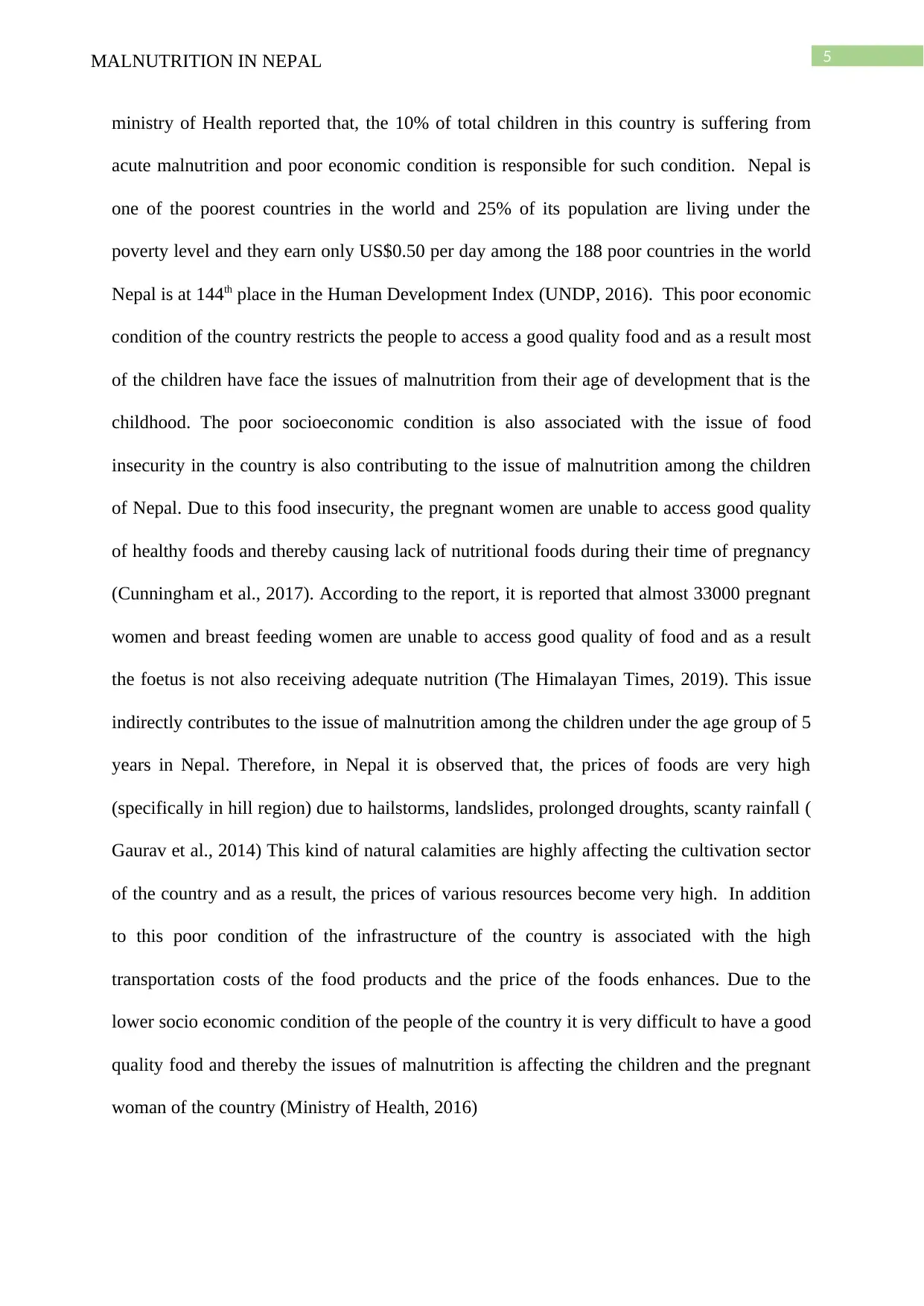
5MALNUTRITION IN NEPAL
ministry of Health reported that, the 10% of total children in this country is suffering from
acute malnutrition and poor economic condition is responsible for such condition. Nepal is
one of the poorest countries in the world and 25% of its population are living under the
poverty level and they earn only US$0.50 per day among the 188 poor countries in the world
Nepal is at 144th place in the Human Development Index (UNDP, 2016). This poor economic
condition of the country restricts the people to access a good quality food and as a result most
of the children have face the issues of malnutrition from their age of development that is the
childhood. The poor socioeconomic condition is also associated with the issue of food
insecurity in the country is also contributing to the issue of malnutrition among the children
of Nepal. Due to this food insecurity, the pregnant women are unable to access good quality
of healthy foods and thereby causing lack of nutritional foods during their time of pregnancy
(Cunningham et al., 2017). According to the report, it is reported that almost 33000 pregnant
women and breast feeding women are unable to access good quality of food and as a result
the foetus is not also receiving adequate nutrition (The Himalayan Times, 2019). This issue
indirectly contributes to the issue of malnutrition among the children under the age group of 5
years in Nepal. Therefore, in Nepal it is observed that, the prices of foods are very high
(specifically in hill region) due to hailstorms, landslides, prolonged droughts, scanty rainfall (
Gaurav et al., 2014) This kind of natural calamities are highly affecting the cultivation sector
of the country and as a result, the prices of various resources become very high. In addition
to this poor condition of the infrastructure of the country is associated with the high
transportation costs of the food products and the price of the foods enhances. Due to the
lower socio economic condition of the people of the country it is very difficult to have a good
quality food and thereby the issues of malnutrition is affecting the children and the pregnant
woman of the country (Ministry of Health, 2016)
ministry of Health reported that, the 10% of total children in this country is suffering from
acute malnutrition and poor economic condition is responsible for such condition. Nepal is
one of the poorest countries in the world and 25% of its population are living under the
poverty level and they earn only US$0.50 per day among the 188 poor countries in the world
Nepal is at 144th place in the Human Development Index (UNDP, 2016). This poor economic
condition of the country restricts the people to access a good quality food and as a result most
of the children have face the issues of malnutrition from their age of development that is the
childhood. The poor socioeconomic condition is also associated with the issue of food
insecurity in the country is also contributing to the issue of malnutrition among the children
of Nepal. Due to this food insecurity, the pregnant women are unable to access good quality
of healthy foods and thereby causing lack of nutritional foods during their time of pregnancy
(Cunningham et al., 2017). According to the report, it is reported that almost 33000 pregnant
women and breast feeding women are unable to access good quality of food and as a result
the foetus is not also receiving adequate nutrition (The Himalayan Times, 2019). This issue
indirectly contributes to the issue of malnutrition among the children under the age group of 5
years in Nepal. Therefore, in Nepal it is observed that, the prices of foods are very high
(specifically in hill region) due to hailstorms, landslides, prolonged droughts, scanty rainfall (
Gaurav et al., 2014) This kind of natural calamities are highly affecting the cultivation sector
of the country and as a result, the prices of various resources become very high. In addition
to this poor condition of the infrastructure of the country is associated with the high
transportation costs of the food products and the price of the foods enhances. Due to the
lower socio economic condition of the people of the country it is very difficult to have a good
quality food and thereby the issues of malnutrition is affecting the children and the pregnant
woman of the country (Ministry of Health, 2016)
⊘ This is a preview!⊘
Do you want full access?
Subscribe today to unlock all pages.

Trusted by 1+ million students worldwide
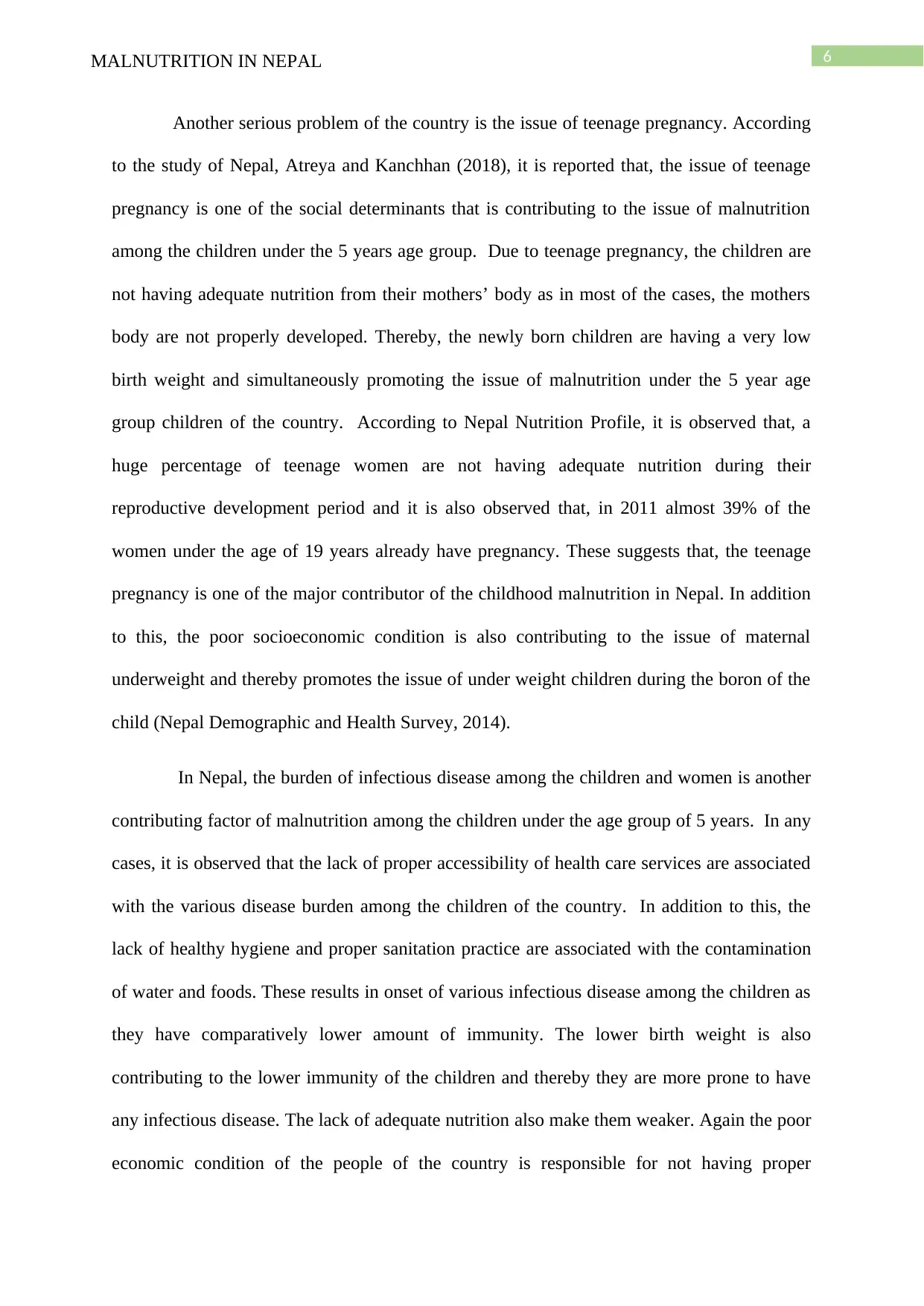
6MALNUTRITION IN NEPAL
Another serious problem of the country is the issue of teenage pregnancy. According
to the study of Nepal, Atreya and Kanchhan (2018), it is reported that, the issue of teenage
pregnancy is one of the social determinants that is contributing to the issue of malnutrition
among the children under the 5 years age group. Due to teenage pregnancy, the children are
not having adequate nutrition from their mothers’ body as in most of the cases, the mothers
body are not properly developed. Thereby, the newly born children are having a very low
birth weight and simultaneously promoting the issue of malnutrition under the 5 year age
group children of the country. According to Nepal Nutrition Profile, it is observed that, a
huge percentage of teenage women are not having adequate nutrition during their
reproductive development period and it is also observed that, in 2011 almost 39% of the
women under the age of 19 years already have pregnancy. These suggests that, the teenage
pregnancy is one of the major contributor of the childhood malnutrition in Nepal. In addition
to this, the poor socioeconomic condition is also contributing to the issue of maternal
underweight and thereby promotes the issue of under weight children during the boron of the
child (Nepal Demographic and Health Survey, 2014).
In Nepal, the burden of infectious disease among the children and women is another
contributing factor of malnutrition among the children under the age group of 5 years. In any
cases, it is observed that the lack of proper accessibility of health care services are associated
with the various disease burden among the children of the country. In addition to this, the
lack of healthy hygiene and proper sanitation practice are associated with the contamination
of water and foods. These results in onset of various infectious disease among the children as
they have comparatively lower amount of immunity. The lower birth weight is also
contributing to the lower immunity of the children and thereby they are more prone to have
any infectious disease. The lack of adequate nutrition also make them weaker. Again the poor
economic condition of the people of the country is responsible for not having proper
Another serious problem of the country is the issue of teenage pregnancy. According
to the study of Nepal, Atreya and Kanchhan (2018), it is reported that, the issue of teenage
pregnancy is one of the social determinants that is contributing to the issue of malnutrition
among the children under the 5 years age group. Due to teenage pregnancy, the children are
not having adequate nutrition from their mothers’ body as in most of the cases, the mothers
body are not properly developed. Thereby, the newly born children are having a very low
birth weight and simultaneously promoting the issue of malnutrition under the 5 year age
group children of the country. According to Nepal Nutrition Profile, it is observed that, a
huge percentage of teenage women are not having adequate nutrition during their
reproductive development period and it is also observed that, in 2011 almost 39% of the
women under the age of 19 years already have pregnancy. These suggests that, the teenage
pregnancy is one of the major contributor of the childhood malnutrition in Nepal. In addition
to this, the poor socioeconomic condition is also contributing to the issue of maternal
underweight and thereby promotes the issue of under weight children during the boron of the
child (Nepal Demographic and Health Survey, 2014).
In Nepal, the burden of infectious disease among the children and women is another
contributing factor of malnutrition among the children under the age group of 5 years. In any
cases, it is observed that the lack of proper accessibility of health care services are associated
with the various disease burden among the children of the country. In addition to this, the
lack of healthy hygiene and proper sanitation practice are associated with the contamination
of water and foods. These results in onset of various infectious disease among the children as
they have comparatively lower amount of immunity. The lower birth weight is also
contributing to the lower immunity of the children and thereby they are more prone to have
any infectious disease. The lack of adequate nutrition also make them weaker. Again the poor
economic condition of the people of the country is responsible for not having proper
Paraphrase This Document
Need a fresh take? Get an instant paraphrase of this document with our AI Paraphraser
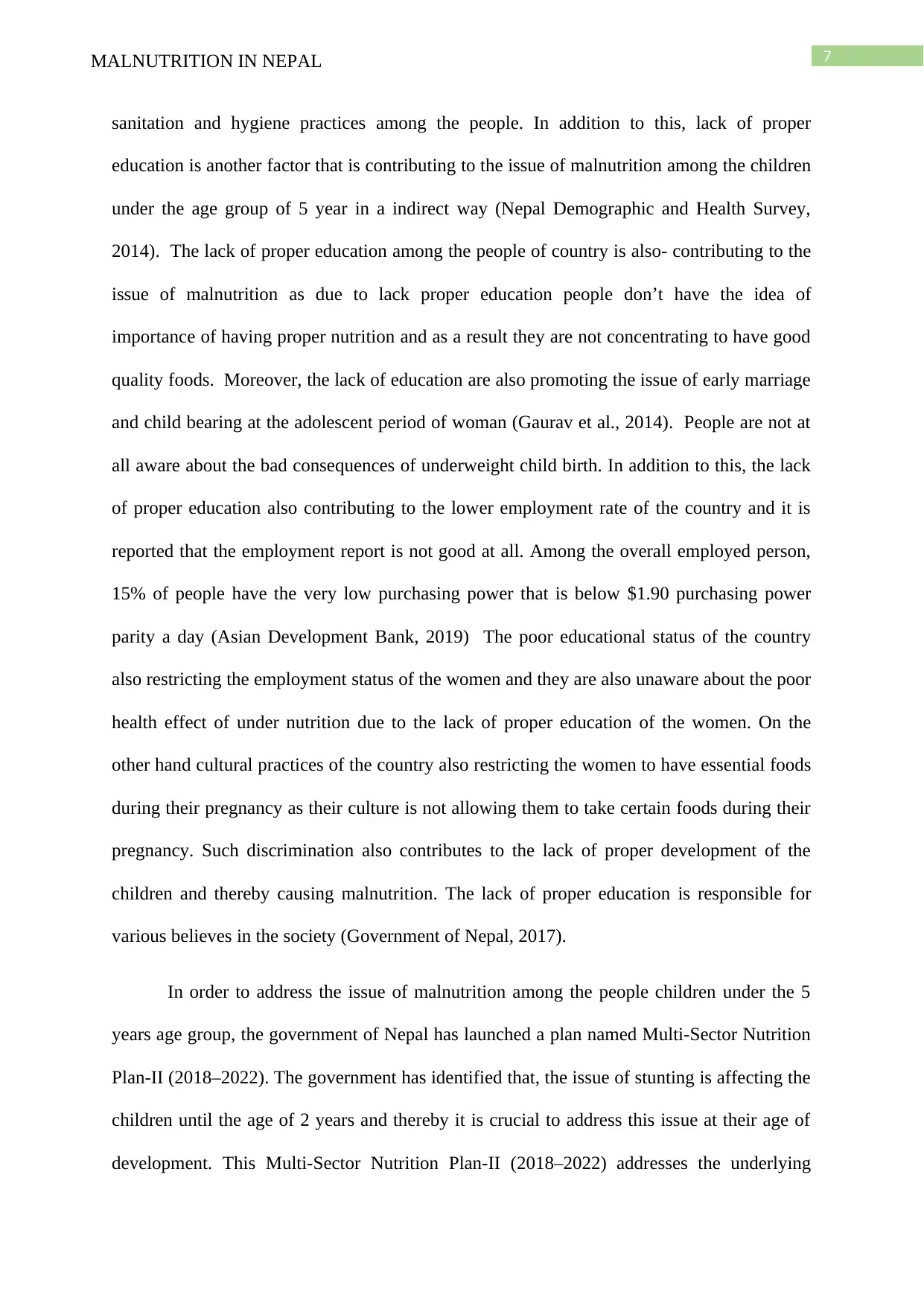
7MALNUTRITION IN NEPAL
sanitation and hygiene practices among the people. In addition to this, lack of proper
education is another factor that is contributing to the issue of malnutrition among the children
under the age group of 5 year in a indirect way (Nepal Demographic and Health Survey,
2014). The lack of proper education among the people of country is also- contributing to the
issue of malnutrition as due to lack proper education people don’t have the idea of
importance of having proper nutrition and as a result they are not concentrating to have good
quality foods. Moreover, the lack of education are also promoting the issue of early marriage
and child bearing at the adolescent period of woman (Gaurav et al., 2014). People are not at
all aware about the bad consequences of underweight child birth. In addition to this, the lack
of proper education also contributing to the lower employment rate of the country and it is
reported that the employment report is not good at all. Among the overall employed person,
15% of people have the very low purchasing power that is below $1.90 purchasing power
parity a day (Asian Development Bank, 2019) The poor educational status of the country
also restricting the employment status of the women and they are also unaware about the poor
health effect of under nutrition due to the lack of proper education of the women. On the
other hand cultural practices of the country also restricting the women to have essential foods
during their pregnancy as their culture is not allowing them to take certain foods during their
pregnancy. Such discrimination also contributes to the lack of proper development of the
children and thereby causing malnutrition. The lack of proper education is responsible for
various believes in the society (Government of Nepal, 2017).
In order to address the issue of malnutrition among the people children under the 5
years age group, the government of Nepal has launched a plan named Multi-Sector Nutrition
Plan-II (2018–2022). The government has identified that, the issue of stunting is affecting the
children until the age of 2 years and thereby it is crucial to address this issue at their age of
development. This Multi-Sector Nutrition Plan-II (2018–2022) addresses the underlying
sanitation and hygiene practices among the people. In addition to this, lack of proper
education is another factor that is contributing to the issue of malnutrition among the children
under the age group of 5 year in a indirect way (Nepal Demographic and Health Survey,
2014). The lack of proper education among the people of country is also- contributing to the
issue of malnutrition as due to lack proper education people don’t have the idea of
importance of having proper nutrition and as a result they are not concentrating to have good
quality foods. Moreover, the lack of education are also promoting the issue of early marriage
and child bearing at the adolescent period of woman (Gaurav et al., 2014). People are not at
all aware about the bad consequences of underweight child birth. In addition to this, the lack
of proper education also contributing to the lower employment rate of the country and it is
reported that the employment report is not good at all. Among the overall employed person,
15% of people have the very low purchasing power that is below $1.90 purchasing power
parity a day (Asian Development Bank, 2019) The poor educational status of the country
also restricting the employment status of the women and they are also unaware about the poor
health effect of under nutrition due to the lack of proper education of the women. On the
other hand cultural practices of the country also restricting the women to have essential foods
during their pregnancy as their culture is not allowing them to take certain foods during their
pregnancy. Such discrimination also contributes to the lack of proper development of the
children and thereby causing malnutrition. The lack of proper education is responsible for
various believes in the society (Government of Nepal, 2017).
In order to address the issue of malnutrition among the people children under the 5
years age group, the government of Nepal has launched a plan named Multi-Sector Nutrition
Plan-II (2018–2022). The government has identified that, the issue of stunting is affecting the
children until the age of 2 years and thereby it is crucial to address this issue at their age of
development. This Multi-Sector Nutrition Plan-II (2018–2022) addresses the underlying
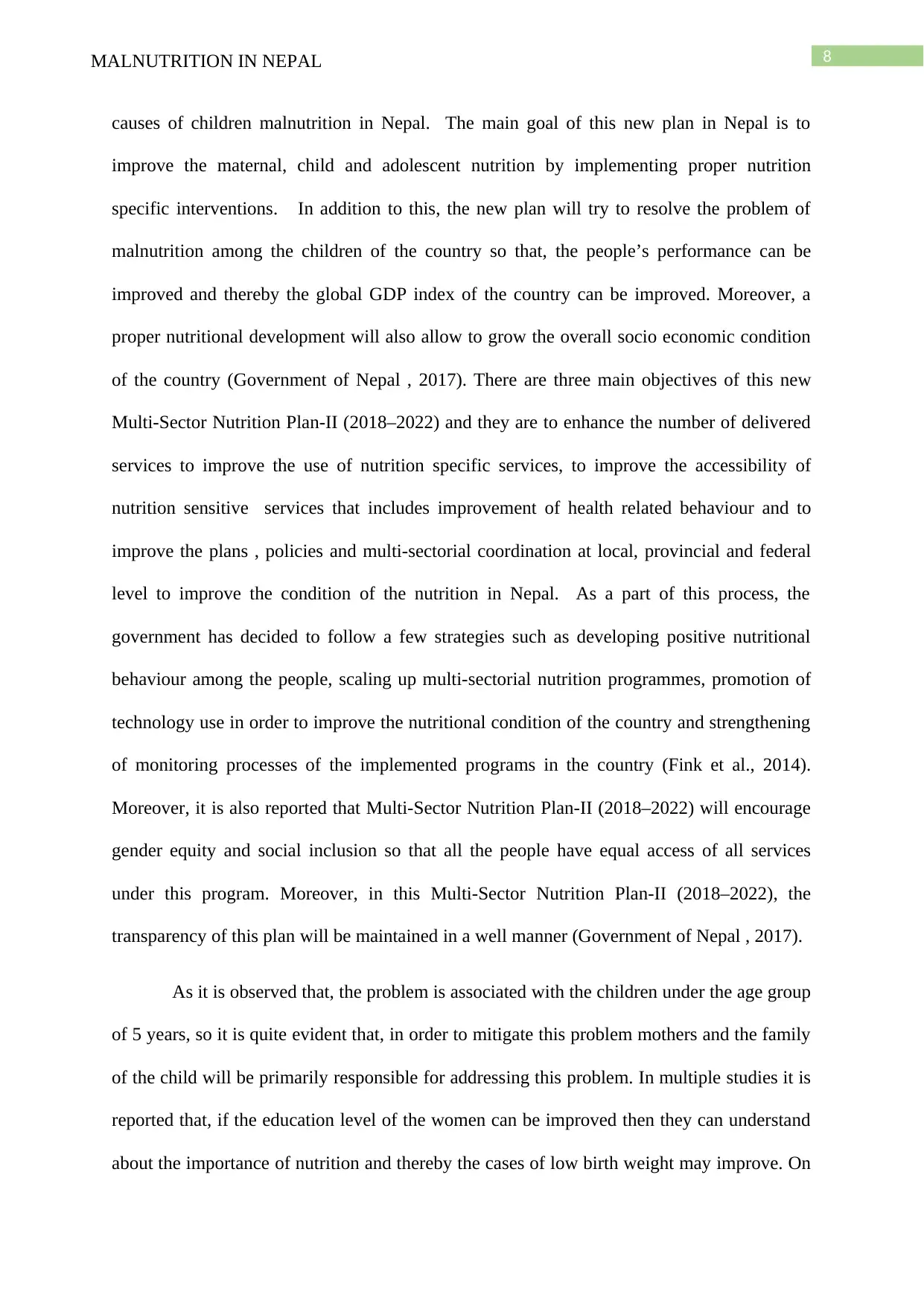
8MALNUTRITION IN NEPAL
causes of children malnutrition in Nepal. The main goal of this new plan in Nepal is to
improve the maternal, child and adolescent nutrition by implementing proper nutrition
specific interventions. In addition to this, the new plan will try to resolve the problem of
malnutrition among the children of the country so that, the people’s performance can be
improved and thereby the global GDP index of the country can be improved. Moreover, a
proper nutritional development will also allow to grow the overall socio economic condition
of the country (Government of Nepal , 2017). There are three main objectives of this new
Multi-Sector Nutrition Plan-II (2018–2022) and they are to enhance the number of delivered
services to improve the use of nutrition specific services, to improve the accessibility of
nutrition sensitive services that includes improvement of health related behaviour and to
improve the plans , policies and multi-sectorial coordination at local, provincial and federal
level to improve the condition of the nutrition in Nepal. As a part of this process, the
government has decided to follow a few strategies such as developing positive nutritional
behaviour among the people, scaling up multi-sectorial nutrition programmes, promotion of
technology use in order to improve the nutritional condition of the country and strengthening
of monitoring processes of the implemented programs in the country (Fink et al., 2014).
Moreover, it is also reported that Multi-Sector Nutrition Plan-II (2018–2022) will encourage
gender equity and social inclusion so that all the people have equal access of all services
under this program. Moreover, in this Multi-Sector Nutrition Plan-II (2018–2022), the
transparency of this plan will be maintained in a well manner (Government of Nepal , 2017).
As it is observed that, the problem is associated with the children under the age group
of 5 years, so it is quite evident that, in order to mitigate this problem mothers and the family
of the child will be primarily responsible for addressing this problem. In multiple studies it is
reported that, if the education level of the women can be improved then they can understand
about the importance of nutrition and thereby the cases of low birth weight may improve. On
causes of children malnutrition in Nepal. The main goal of this new plan in Nepal is to
improve the maternal, child and adolescent nutrition by implementing proper nutrition
specific interventions. In addition to this, the new plan will try to resolve the problem of
malnutrition among the children of the country so that, the people’s performance can be
improved and thereby the global GDP index of the country can be improved. Moreover, a
proper nutritional development will also allow to grow the overall socio economic condition
of the country (Government of Nepal , 2017). There are three main objectives of this new
Multi-Sector Nutrition Plan-II (2018–2022) and they are to enhance the number of delivered
services to improve the use of nutrition specific services, to improve the accessibility of
nutrition sensitive services that includes improvement of health related behaviour and to
improve the plans , policies and multi-sectorial coordination at local, provincial and federal
level to improve the condition of the nutrition in Nepal. As a part of this process, the
government has decided to follow a few strategies such as developing positive nutritional
behaviour among the people, scaling up multi-sectorial nutrition programmes, promotion of
technology use in order to improve the nutritional condition of the country and strengthening
of monitoring processes of the implemented programs in the country (Fink et al., 2014).
Moreover, it is also reported that Multi-Sector Nutrition Plan-II (2018–2022) will encourage
gender equity and social inclusion so that all the people have equal access of all services
under this program. Moreover, in this Multi-Sector Nutrition Plan-II (2018–2022), the
transparency of this plan will be maintained in a well manner (Government of Nepal , 2017).
As it is observed that, the problem is associated with the children under the age group
of 5 years, so it is quite evident that, in order to mitigate this problem mothers and the family
of the child will be primarily responsible for addressing this problem. In multiple studies it is
reported that, if the education level of the women can be improved then they can understand
about the importance of nutrition and thereby the cases of low birth weight may improve. On
⊘ This is a preview!⊘
Do you want full access?
Subscribe today to unlock all pages.

Trusted by 1+ million students worldwide
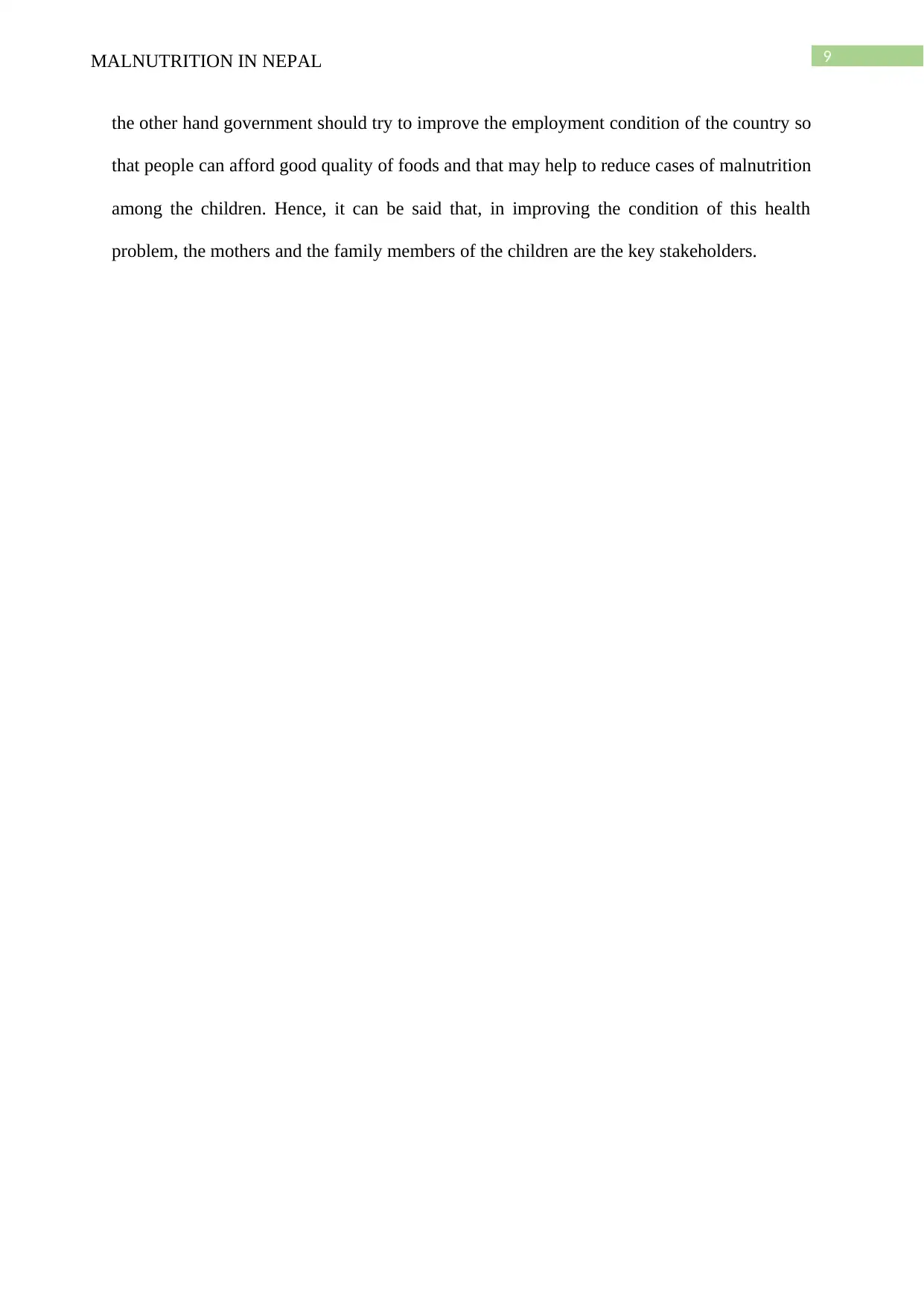
9MALNUTRITION IN NEPAL
the other hand government should try to improve the employment condition of the country so
that people can afford good quality of foods and that may help to reduce cases of malnutrition
among the children. Hence, it can be said that, in improving the condition of this health
problem, the mothers and the family members of the children are the key stakeholders.
the other hand government should try to improve the employment condition of the country so
that people can afford good quality of foods and that may help to reduce cases of malnutrition
among the children. Hence, it can be said that, in improving the condition of this health
problem, the mothers and the family members of the children are the key stakeholders.
Paraphrase This Document
Need a fresh take? Get an instant paraphrase of this document with our AI Paraphraser
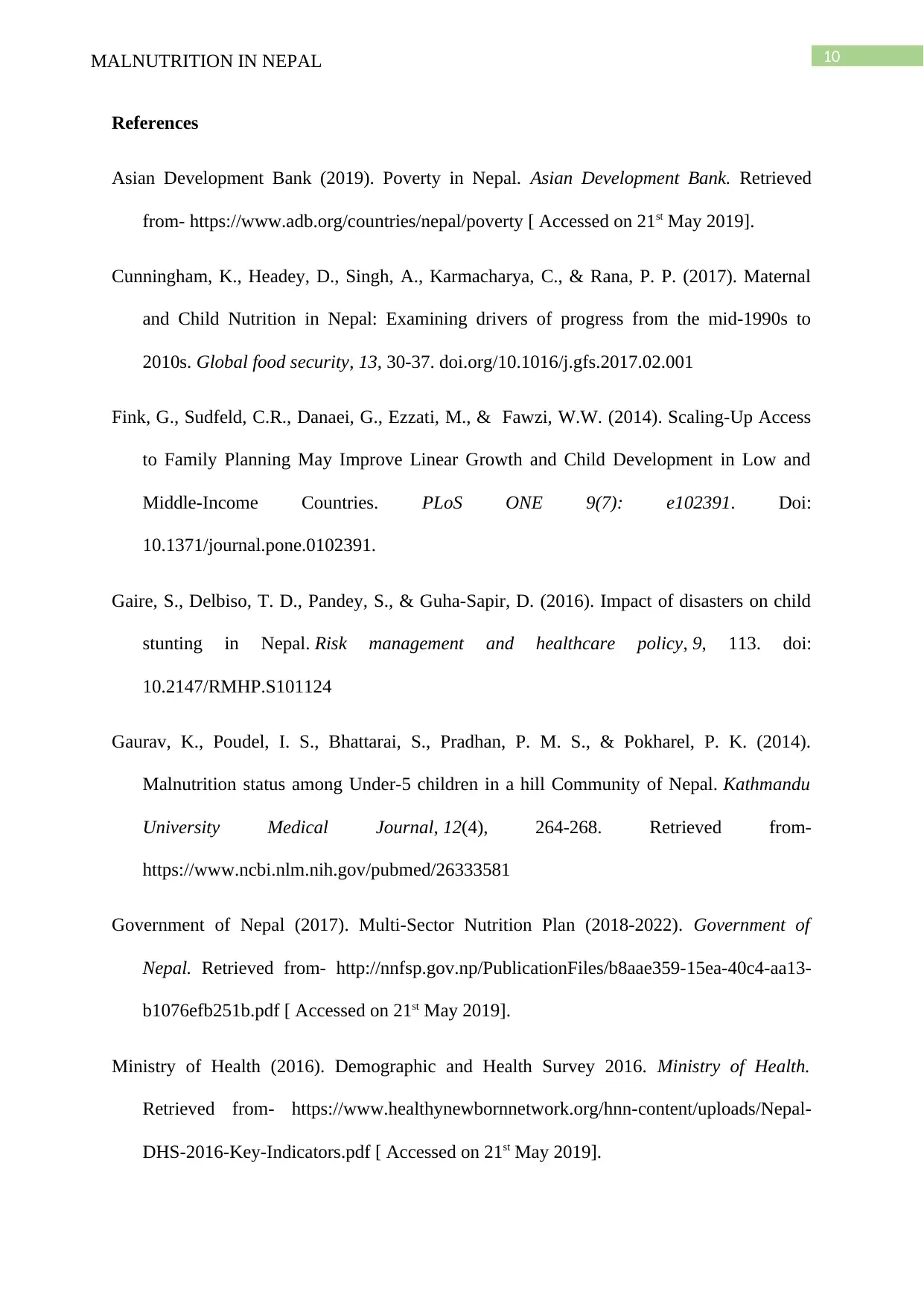
10MALNUTRITION IN NEPAL
References
Asian Development Bank (2019). Poverty in Nepal. Asian Development Bank. Retrieved
from- https://www.adb.org/countries/nepal/poverty [ Accessed on 21st May 2019].
Cunningham, K., Headey, D., Singh, A., Karmacharya, C., & Rana, P. P. (2017). Maternal
and Child Nutrition in Nepal: Examining drivers of progress from the mid-1990s to
2010s. Global food security, 13, 30-37. doi.org/10.1016/j.gfs.2017.02.001
Fink, G., Sudfeld, C.R., Danaei, G., Ezzati, M., & Fawzi, W.W. (2014). Scaling-Up Access
to Family Planning May Improve Linear Growth and Child Development in Low and
Middle-Income Countries. PLoS ONE 9(7): e102391. Doi:
10.1371/journal.pone.0102391.
Gaire, S., Delbiso, T. D., Pandey, S., & Guha-Sapir, D. (2016). Impact of disasters on child
stunting in Nepal. Risk management and healthcare policy, 9, 113. doi:
10.2147/RMHP.S101124
Gaurav, K., Poudel, I. S., Bhattarai, S., Pradhan, P. M. S., & Pokharel, P. K. (2014).
Malnutrition status among Under-5 children in a hill Community of Nepal. Kathmandu
University Medical Journal, 12(4), 264-268. Retrieved from-
https://www.ncbi.nlm.nih.gov/pubmed/26333581
Government of Nepal (2017). Multi-Sector Nutrition Plan (2018-2022). Government of
Nepal. Retrieved from- http://nnfsp.gov.np/PublicationFiles/b8aae359-15ea-40c4-aa13-
b1076efb251b.pdf [ Accessed on 21st May 2019].
Ministry of Health (2016). Demographic and Health Survey 2016. Ministry of Health.
Retrieved from- https://www.healthynewbornnetwork.org/hnn-content/uploads/Nepal-
DHS-2016-Key-Indicators.pdf [ Accessed on 21st May 2019].
References
Asian Development Bank (2019). Poverty in Nepal. Asian Development Bank. Retrieved
from- https://www.adb.org/countries/nepal/poverty [ Accessed on 21st May 2019].
Cunningham, K., Headey, D., Singh, A., Karmacharya, C., & Rana, P. P. (2017). Maternal
and Child Nutrition in Nepal: Examining drivers of progress from the mid-1990s to
2010s. Global food security, 13, 30-37. doi.org/10.1016/j.gfs.2017.02.001
Fink, G., Sudfeld, C.R., Danaei, G., Ezzati, M., & Fawzi, W.W. (2014). Scaling-Up Access
to Family Planning May Improve Linear Growth and Child Development in Low and
Middle-Income Countries. PLoS ONE 9(7): e102391. Doi:
10.1371/journal.pone.0102391.
Gaire, S., Delbiso, T. D., Pandey, S., & Guha-Sapir, D. (2016). Impact of disasters on child
stunting in Nepal. Risk management and healthcare policy, 9, 113. doi:
10.2147/RMHP.S101124
Gaurav, K., Poudel, I. S., Bhattarai, S., Pradhan, P. M. S., & Pokharel, P. K. (2014).
Malnutrition status among Under-5 children in a hill Community of Nepal. Kathmandu
University Medical Journal, 12(4), 264-268. Retrieved from-
https://www.ncbi.nlm.nih.gov/pubmed/26333581
Government of Nepal (2017). Multi-Sector Nutrition Plan (2018-2022). Government of
Nepal. Retrieved from- http://nnfsp.gov.np/PublicationFiles/b8aae359-15ea-40c4-aa13-
b1076efb251b.pdf [ Accessed on 21st May 2019].
Ministry of Health (2016). Demographic and Health Survey 2016. Ministry of Health.
Retrieved from- https://www.healthynewbornnetwork.org/hnn-content/uploads/Nepal-
DHS-2016-Key-Indicators.pdf [ Accessed on 21st May 2019].
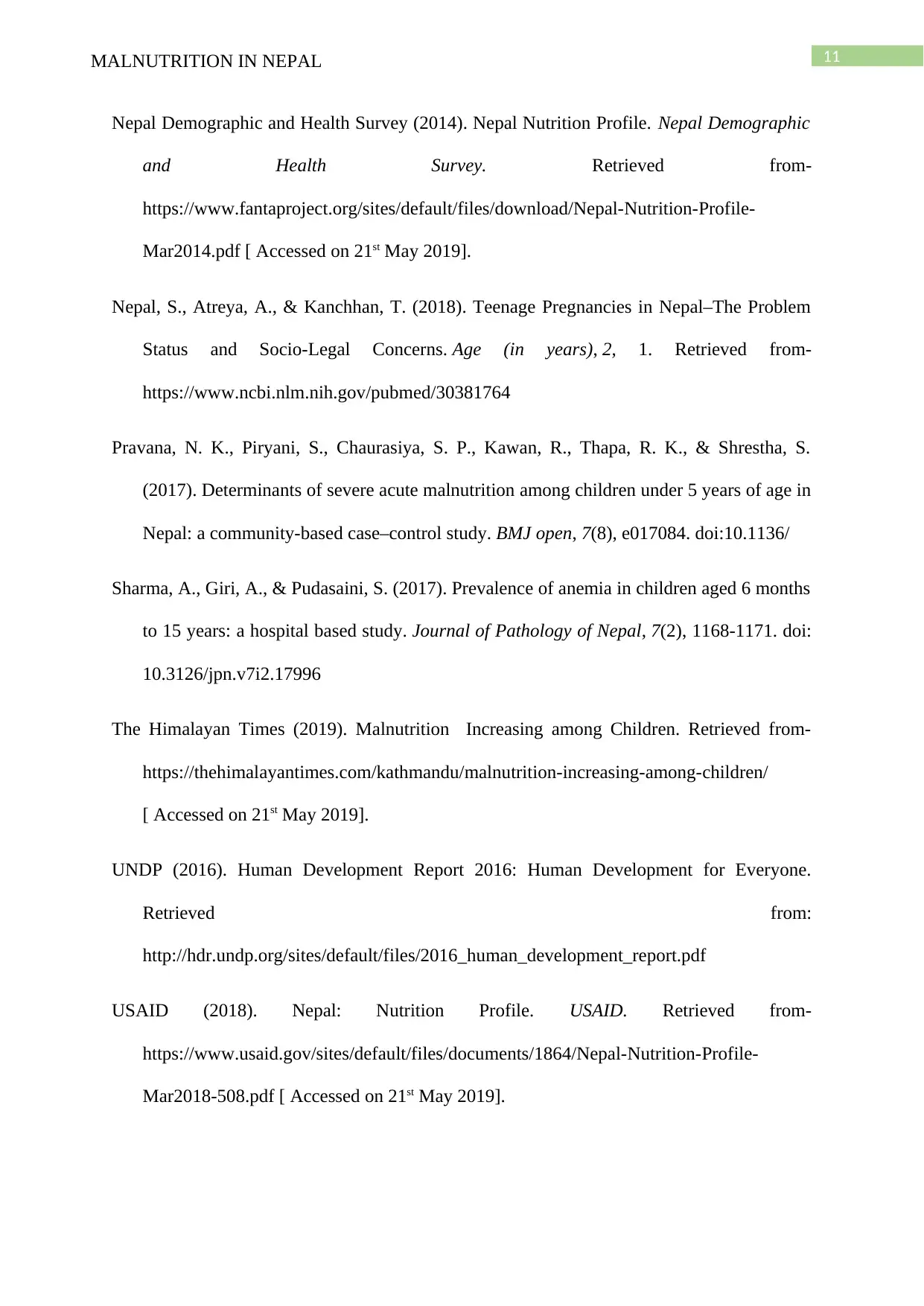
11MALNUTRITION IN NEPAL
Nepal Demographic and Health Survey (2014). Nepal Nutrition Profile. Nepal Demographic
and Health Survey. Retrieved from-
https://www.fantaproject.org/sites/default/files/download/Nepal-Nutrition-Profile-
Mar2014.pdf [ Accessed on 21st May 2019].
Nepal, S., Atreya, A., & Kanchhan, T. (2018). Teenage Pregnancies in Nepal–The Problem
Status and Socio-Legal Concerns. Age (in years), 2, 1. Retrieved from-
https://www.ncbi.nlm.nih.gov/pubmed/30381764
Pravana, N. K., Piryani, S., Chaurasiya, S. P., Kawan, R., Thapa, R. K., & Shrestha, S.
(2017). Determinants of severe acute malnutrition among children under 5 years of age in
Nepal: a community-based case–control study. BMJ open, 7(8), e017084. doi:10.1136/
Sharma, A., Giri, A., & Pudasaini, S. (2017). Prevalence of anemia in children aged 6 months
to 15 years: a hospital based study. Journal of Pathology of Nepal, 7(2), 1168-1171. doi:
10.3126/jpn.v7i2.17996
The Himalayan Times (2019). Malnutrition Increasing among Children. Retrieved from-
https://thehimalayantimes.com/kathmandu/malnutrition-increasing-among-children/
[ Accessed on 21st May 2019].
UNDP (2016). Human Development Report 2016: Human Development for Everyone.
Retrieved from:
http://hdr.undp.org/sites/default/files/2016_human_development_report.pdf
USAID (2018). Nepal: Nutrition Profile. USAID. Retrieved from-
https://www.usaid.gov/sites/default/files/documents/1864/Nepal-Nutrition-Profile-
Mar2018-508.pdf [ Accessed on 21st May 2019].
Nepal Demographic and Health Survey (2014). Nepal Nutrition Profile. Nepal Demographic
and Health Survey. Retrieved from-
https://www.fantaproject.org/sites/default/files/download/Nepal-Nutrition-Profile-
Mar2014.pdf [ Accessed on 21st May 2019].
Nepal, S., Atreya, A., & Kanchhan, T. (2018). Teenage Pregnancies in Nepal–The Problem
Status and Socio-Legal Concerns. Age (in years), 2, 1. Retrieved from-
https://www.ncbi.nlm.nih.gov/pubmed/30381764
Pravana, N. K., Piryani, S., Chaurasiya, S. P., Kawan, R., Thapa, R. K., & Shrestha, S.
(2017). Determinants of severe acute malnutrition among children under 5 years of age in
Nepal: a community-based case–control study. BMJ open, 7(8), e017084. doi:10.1136/
Sharma, A., Giri, A., & Pudasaini, S. (2017). Prevalence of anemia in children aged 6 months
to 15 years: a hospital based study. Journal of Pathology of Nepal, 7(2), 1168-1171. doi:
10.3126/jpn.v7i2.17996
The Himalayan Times (2019). Malnutrition Increasing among Children. Retrieved from-
https://thehimalayantimes.com/kathmandu/malnutrition-increasing-among-children/
[ Accessed on 21st May 2019].
UNDP (2016). Human Development Report 2016: Human Development for Everyone.
Retrieved from:
http://hdr.undp.org/sites/default/files/2016_human_development_report.pdf
USAID (2018). Nepal: Nutrition Profile. USAID. Retrieved from-
https://www.usaid.gov/sites/default/files/documents/1864/Nepal-Nutrition-Profile-
Mar2018-508.pdf [ Accessed on 21st May 2019].
⊘ This is a preview!⊘
Do you want full access?
Subscribe today to unlock all pages.

Trusted by 1+ million students worldwide
1 out of 13
Related Documents
Your All-in-One AI-Powered Toolkit for Academic Success.
+13062052269
info@desklib.com
Available 24*7 on WhatsApp / Email
![[object Object]](/_next/static/media/star-bottom.7253800d.svg)
Unlock your academic potential
Copyright © 2020–2025 A2Z Services. All Rights Reserved. Developed and managed by ZUCOL.




